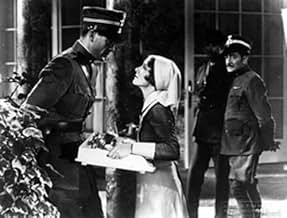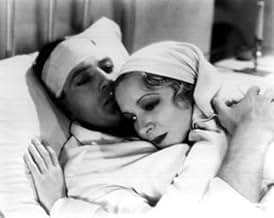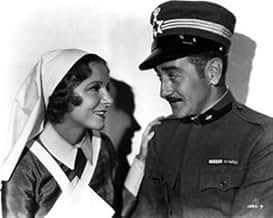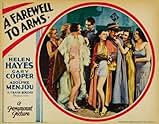IMDb-BEWERTUNG
6,4/10
7063
IHRE BEWERTUNG
Füge eine Handlung in deiner Sprache hinzuAn American ambulance driver and an English nurse fall in love in Italy during World War I.An American ambulance driver and an English nurse fall in love in Italy during World War I.An American ambulance driver and an English nurse fall in love in Italy during World War I.
- 2 Oscars gewonnen
- 4 Gewinne & 2 Nominierungen insgesamt
Alice Adair
- Cafe Girl
- (Nicht genannt)
Henry Armetta
- Bonello
- (Nicht genannt)
Herman Bing
- Swiss Postal Clerk
- (Nicht genannt)
Agostino Borgato
- Giulio
- (Nicht genannt)
Robert Cauterio
- Gordini
- (Nicht genannt)
Marcelle Corday
- Swiss Nurse
- (Nicht genannt)
Gino Corrado
- Italian Soldier
- (Nicht genannt)
Peggy Cunningham
- Molly
- (Nicht genannt)
George Humbert
- Piani
- (Nicht genannt)
William Irving
- Frustrated Opera Singer
- (Nicht genannt)
Handlung
WUSSTEST DU SCHON:
- WissenswertesErnest Hemingway hated this interpretation of his novel, as he felt it was overly romantic. That didn't stop him, however, from becoming lifelong friends with Gary Cooper, whom he met several years later. In fact, it was Hemingway who would insist that Cooper be cast in the lead of the adaptation of his novel Wem die Stunde schlägt (1943) 11 years later. However, the two made a point of never discussing this film.
- PatzerA night attack is shown. During World War I there was very little flying at night and the night attacks that did occur were limited to big cities. It was almost impossible for a plane to attack specific targets in a large city, so effectively attacking people on a road in the dark was not possible, and did not happen.
- Zitate
Frederic: We've never been apart, really. Not since we met.
Catherine: Not since we met.
Frederic: And never can be.
Catherine: Never apart.
Frederic: In life and in death. Say it Cat.
Catherine: In life and in death, we'll never be parted.
Frederic: You do believe that, don't you, Cat?
Catherine: I believe it, and I'm not afraid.
- Crazy CreditsIn the original 1932 credits, the credits are punctuated by aerial bomb blasts, and every time there is a blast, a credit disappears to be replaced by the next one.
- Alternative VersionenSPOILER: Paramount decided, after much disagreement, to keep Hemingway's original ending and fade out after the death of Catherine Barkley. This ending was kept for the European release, but a new ending in which Barkley lives was later added to the U.S. release.
- VerbindungenEdited into Your Afternoon Movie: Farewell to Arms (2023)
Ausgewählte Rezension
The works of Ernest Hemingway have not always translated well to the cinema. The Gary Cooper/Ingrid Bergman "For Whom the Bell Tolls" and David O. Selznick's version of "A Farewell to Arms", although attractively photographed, are two of the dullest and most slow-moving films ever committed to celluloid. "The Snows of Kilimanjaro" is slightly better, but still by no means as good as it should be, given its stellar cast. Howard Hawks's version of "To Have and Have Not" is a good film, but that is probably because its plot has very little to do with that of the novel on which it is supposedly based.
The 1932 version of "A Farewell to Arms" was the first time a film had been based on one of Hemingway's works, and there is an obvious difference between it and the 1957 remake; it is only slightly more than half the length, at 80 minutes as opposed to 152. Over the quarter-century between the dates of the two films there had been a change in the way Hemingway was seen. In 1932 he was still an up-and-coming young author; by 1957, although he was still alive and only in his late fifties, he had achieved the status of Great American Novelist, and the film that was made in that year suffers from an over-reverential attitude to his work, treating it like a solemn classical text that needed an equally solemn cinematic treatment to do it justice.
The film tells the story of the romance between Frederick, an American volunteer serving with the Italian Army as an ambulance driver, and Catherine, a nurse with the British Red Cross. Frederick deserts and crosses the border into neutral Switzerland, to be with Catherine, whom he has secretly married and who is pregnant.
It has been pointed out that the moral of the film is precisely the opposite of that of "Casablanca". In that film Rick and Ilsa give up their chance of happiness together because "the problems of three little people don't amount to a hill of beans in this crazy world". What matters is the war, and the Allied struggle for victory. In "A Farewell to Arms", however, the moral is that the personal happiness of Frederick and Catherine matters more than the great historical events from which they are escaping. This reversal in emphasis between the two films probably reflects a reversal in public attitudes which took place in the intervening decade between 1932 and 1942. In 1932, a year before Hitler came to power, there was a sense of disillusionment with war, even in those countries which had finished on the winning side in 1914-18; the First World War was widely seen as senseless slaughter. Ten years later, the rise of Nazism and the outbreak of the Second World War had changed attitudes so that it was once again fashionable to talk about a "just war" against evil. (By 1957, during the Cold War, the pendulum had partially swung back in the opposite direction; Selznick's film might have been a flop, but there were some very good anti-war films from that period, such as Kubrick's "Paths of Glory").
Seen from a modern perspective, the film looks and sounds very dated. The sound quality is poor and the action looks jerky. These problems were, of course, common to most films from the early thirties, the very dawn of the sound picture era. (It is remarkable how quickly those problems were overcome, when one compares the likes of "A Farewell to Arms" with, say, "Gone with the Wind" from only seven years later). In some respects, however, the director Frank Borzage was able to turn the technical limitations of the period to his advantage. Large-scale realistic battle sequences would not have been possible at this time, but Borzage nevertheless wanted to give some idea of the horror of war in order to show what Frederick is fleeing from. In order to do this he resorts to a wordless montage sequence composed of brief shots of the battle, backed by some highly dramatic music. The result is a sort of cinematic equivalent of Impressionism, serving to give as vivid an impression of warfare as a more detailed picture ever could. (This sequence was probably the reason the film won the Oscar for "Best Cinematography").
The film is better acted than the 1957 remake. Helen Hayes was less glamorous than Jennifer Jones, and has an even less convincing British accent, but makes a much livelier and more convincing Catherine. Gary Cooper's Frederick is similarly far more animated than Rock Hudson's stony-faced interpretation of the role, and he receives good support from Adolphe Menjou as Frederick's comrade Major Rinaldi. The action is better paced and the film, even if it looks primitive by today's standards, nevertheless has a vigour lacking from many more polished films from more recent times. 7/10
The 1932 version of "A Farewell to Arms" was the first time a film had been based on one of Hemingway's works, and there is an obvious difference between it and the 1957 remake; it is only slightly more than half the length, at 80 minutes as opposed to 152. Over the quarter-century between the dates of the two films there had been a change in the way Hemingway was seen. In 1932 he was still an up-and-coming young author; by 1957, although he was still alive and only in his late fifties, he had achieved the status of Great American Novelist, and the film that was made in that year suffers from an over-reverential attitude to his work, treating it like a solemn classical text that needed an equally solemn cinematic treatment to do it justice.
The film tells the story of the romance between Frederick, an American volunteer serving with the Italian Army as an ambulance driver, and Catherine, a nurse with the British Red Cross. Frederick deserts and crosses the border into neutral Switzerland, to be with Catherine, whom he has secretly married and who is pregnant.
It has been pointed out that the moral of the film is precisely the opposite of that of "Casablanca". In that film Rick and Ilsa give up their chance of happiness together because "the problems of three little people don't amount to a hill of beans in this crazy world". What matters is the war, and the Allied struggle for victory. In "A Farewell to Arms", however, the moral is that the personal happiness of Frederick and Catherine matters more than the great historical events from which they are escaping. This reversal in emphasis between the two films probably reflects a reversal in public attitudes which took place in the intervening decade between 1932 and 1942. In 1932, a year before Hitler came to power, there was a sense of disillusionment with war, even in those countries which had finished on the winning side in 1914-18; the First World War was widely seen as senseless slaughter. Ten years later, the rise of Nazism and the outbreak of the Second World War had changed attitudes so that it was once again fashionable to talk about a "just war" against evil. (By 1957, during the Cold War, the pendulum had partially swung back in the opposite direction; Selznick's film might have been a flop, but there were some very good anti-war films from that period, such as Kubrick's "Paths of Glory").
Seen from a modern perspective, the film looks and sounds very dated. The sound quality is poor and the action looks jerky. These problems were, of course, common to most films from the early thirties, the very dawn of the sound picture era. (It is remarkable how quickly those problems were overcome, when one compares the likes of "A Farewell to Arms" with, say, "Gone with the Wind" from only seven years later). In some respects, however, the director Frank Borzage was able to turn the technical limitations of the period to his advantage. Large-scale realistic battle sequences would not have been possible at this time, but Borzage nevertheless wanted to give some idea of the horror of war in order to show what Frederick is fleeing from. In order to do this he resorts to a wordless montage sequence composed of brief shots of the battle, backed by some highly dramatic music. The result is a sort of cinematic equivalent of Impressionism, serving to give as vivid an impression of warfare as a more detailed picture ever could. (This sequence was probably the reason the film won the Oscar for "Best Cinematography").
The film is better acted than the 1957 remake. Helen Hayes was less glamorous than Jennifer Jones, and has an even less convincing British accent, but makes a much livelier and more convincing Catherine. Gary Cooper's Frederick is similarly far more animated than Rock Hudson's stony-faced interpretation of the role, and he receives good support from Adolphe Menjou as Frederick's comrade Major Rinaldi. The action is better paced and the film, even if it looks primitive by today's standards, nevertheless has a vigour lacking from many more polished films from more recent times. 7/10
- JamesHitchcock
- 23. Jan. 2006
- Permalink
Top-Auswahl
Melde dich zum Bewerten an und greife auf die Watchlist für personalisierte Empfehlungen zu.
Details
- Erscheinungsdatum
- Herkunftsland
- Offizieller Standort
- Sprachen
- Auch bekannt als
- A Farewell to Arms
- Drehorte
- Produktionsfirma
- Weitere beteiligte Unternehmen bei IMDbPro anzeigen
Box Office
- Budget
- 799.520 $ (geschätzt)
- Laufzeit1 Stunde 20 Minuten
- Farbe
- Seitenverhältnis
- 1.37 : 1
Zu dieser Seite beitragen
Bearbeitung vorschlagen oder fehlenden Inhalt hinzufügen






































